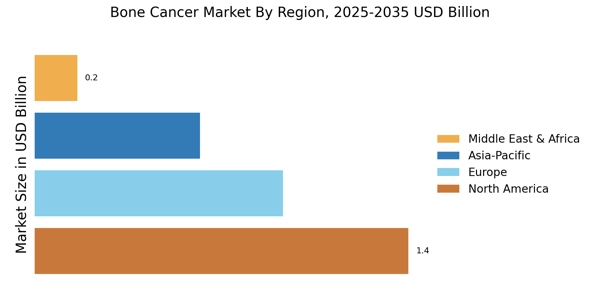Increasing Incidence of Bone Cancer
The rising incidence of bone cancer is a pivotal driver for the Bone Cancer Market. Recent statistics indicate that bone cancer cases are on the rise, with an estimated 3,500 new cases diagnosed annually in certain regions. This increase is attributed to various factors, including genetic predispositions and environmental influences. As awareness grows, more individuals seek medical attention, leading to earlier diagnoses and treatment interventions. Consequently, this trend propels the demand for innovative therapies and diagnostic tools within the Bone Cancer Market. The heightened focus on research and development to address this growing patient population is likely to stimulate market growth, as pharmaceutical companies and healthcare providers strive to meet the evolving needs of patients.
Advancements in Treatment Modalities
Innovations in treatment modalities are significantly shaping the Bone Cancer Market. The introduction of novel therapies, such as immunotherapy and targeted treatments, has transformed the landscape of bone cancer management. For instance, recent advancements have led to the development of drugs that specifically target cancer cells while minimizing damage to healthy tissues. This shift towards more effective and less invasive treatment options is likely to enhance patient outcomes and satisfaction. Furthermore, the market is witnessing an increase in clinical trials aimed at evaluating the efficacy of these new therapies. As a result, the Bone Cancer Market is expected to expand, driven by the continuous evolution of treatment strategies that cater to diverse patient needs.
Technological Innovations in Diagnostics
Technological innovations in diagnostics are significantly influencing the Bone Cancer Market. The advent of advanced imaging techniques, such as MRI and PET scans, has revolutionized the way bone cancer is diagnosed and monitored. These technologies enable healthcare professionals to detect tumors at earlier stages, improving treatment outcomes. Additionally, the integration of artificial intelligence in diagnostic processes is enhancing accuracy and efficiency, allowing for more personalized treatment plans. As diagnostic capabilities continue to evolve, the Bone Cancer Market is expected to expand, driven by the increasing demand for precise and timely diagnosis. This trend underscores the importance of investing in cutting-edge technologies to improve patient care and outcomes.
Rising Awareness and Education Initiatives
Rising awareness and education initiatives play a vital role in shaping the Bone Cancer Market. Increased public knowledge about bone cancer symptoms, risk factors, and treatment options has led to earlier detection and intervention. Various organizations and healthcare providers are actively engaged in campaigns aimed at educating the public, which has resulted in a more informed patient population. This heightened awareness encourages individuals to seek medical advice sooner, thereby increasing the demand for diagnostic services and treatment options. As a result, the Bone Cancer Market is likely to benefit from this trend, as more patients are diagnosed and treated, leading to a greater need for innovative therapies and supportive care.
Growing Investment in Research and Development
Investment in research and development is a crucial driver for the Bone Cancer Market. Pharmaceutical companies and research institutions are increasingly allocating resources to explore new therapeutic avenues and improve existing treatment protocols. This trend is evidenced by the substantial funding directed towards clinical trials and innovative research initiatives. In recent years, the market has seen a surge in collaborations between academia and industry, fostering an environment conducive to breakthroughs in bone cancer therapies. Such investments not only enhance the understanding of bone cancer biology but also facilitate the development of more effective treatment options. Consequently, the Bone Cancer Market is poised for growth as these advancements translate into new products and therapies that address unmet medical needs.


















Leave a Comment